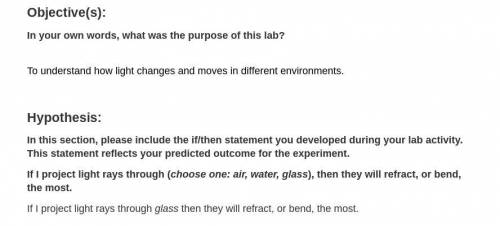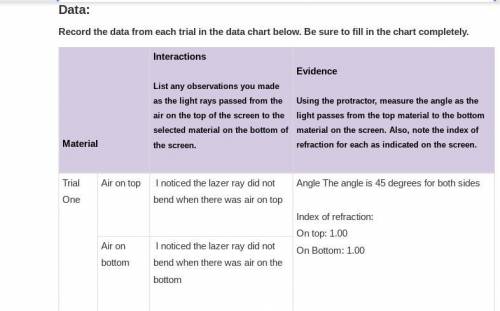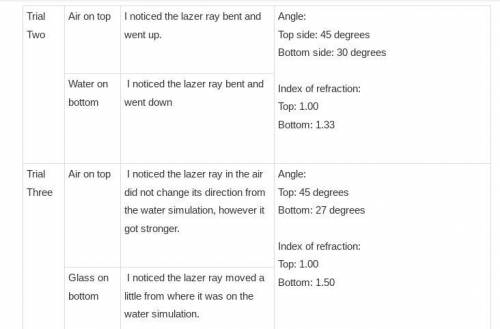
Reset simulation and choose "Mystery A" if you are at an even lab station or choose "Mystery B" if you are at an odd lab station.
Choose the protractor and set the laser to an angle of incidence, θ1, at 30°.
Ignore the reflected ray (the ray that remains in air). Using the protractor, measure the angle of refraction, θ2, of the laser and record in Table 2.
Repeat steps 2 and 3 for angles of incidences of 50° and 70° of your own choosing. Record the results in Table 2.
Calculate sin θ1 and sin θ2 for each trial. Record the results in Table 2.
Table 2
Trial θ1 (degrees) θ2 (degrees) Sin θ1 Sin θ2
1 30 10 .5 .173
2 40 15 .642 .258
3 50 18 .766 .309
4 60 20 .866 .342
5 70 23 .939 .390
Draw a graph of the Sin θ2 vs. Sin θ1on the grid below. Draw in your best-fit line and find the slope. Show slope work below.
What does your slope represent?
Using the chart below of various indices of refraction for various media, identify your mystery material you had in your experiment.
Find the percent error of your observed value (slope) using the identified index of refraction as your accepted value.
Analysis Questions:
Substitute the average value of the index of refraction that you measured in Part A into the equation for index of refraction and calculate the speed of light in the glass. Show work.
What if you conducted this experiment (Part A) under water? Compare and contrast the results you get in such a situation to the results you have from this lab.

Answers: 2


Another question on Physics

Physics, 22.06.2019 12:30
Which levels of government establish and implement educational requirements for minors
Answers: 1

Physics, 23.06.2019 20:00
Neil armstrong, the first human being to step on the moon, left a foot print that is essentially unchanged nearly 50 years later. how is it possible for this, and all the other footprints, tracks and markings, left on the lunar surface to remain unchanged for so long?
Answers: 1

Physics, 23.06.2019 22:30
An engine is designed to obtain energy from the temperature gradient of the ocean. what is the thermodynamic efficiency of such an engine if the temperature of the surface of the water is 59°f (15°c) and the temperature well below the surface is 41°f (5°c)
Answers: 1

Physics, 23.06.2019 23:10
The quantum mechanical model of the hydrogen atom requires that if the orbital quantum number =7, there will be how many permitted orbital magnetic quantum numbers allowed? a. 6 b. 7 c. 11 d. 15
Answers: 2
You know the right answer?
Reset simulation and choose "Mystery A" if you are at an even lab station or choose "Mystery B" if y...
Questions

History, 08.10.2021 14:00




Mathematics, 08.10.2021 14:00



Biology, 08.10.2021 14:00

Chemistry, 08.10.2021 14:00



History, 08.10.2021 14:00

Mathematics, 08.10.2021 14:00




English, 08.10.2021 14:10










